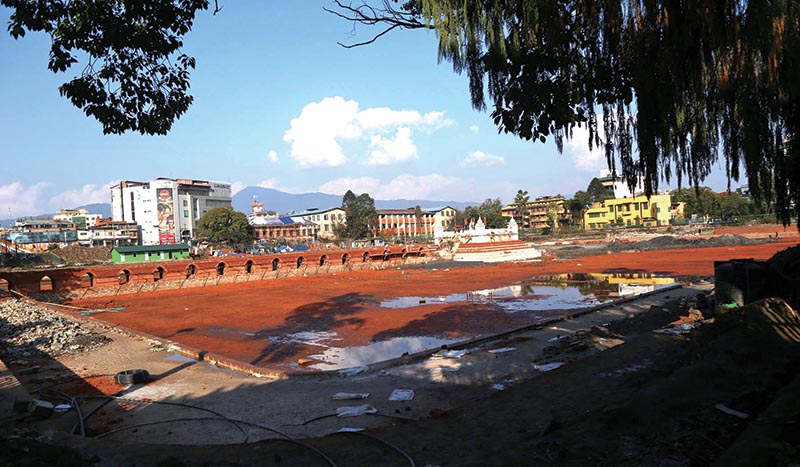Rani Pokhari to get full shape by mid-May
Kathmandu, January 18
More than four years after the devastating 2015 earthquakes, reconstruction of Rani Pokhari and Balgopaleshwor temple, which were completely damaged in the earthquakes, has finally gained momentum.
Authorities concerned have claimed that reconstruction work of the historic and religious site will be completed by mid-May this year.
Reconstruction work had been in limbo for long after Kathmandu Metropolitan City proposed to rebuild the archaeologically important pond and the temple, located in the heart of the city using modern construction materials. The metropolis wanted to turn the pond into a recreational centre.
The metropolis had also hired a private contractor to pump out water and desiccate the pond after President Bidhya Devi Bhandari laid the foundation stone at the pond inaugurating the ‘mega reconstruction campaign’ on 16 January 2016.
The idea of using modern materials and desiccating the pond without proper homework had irked activists, who later obstructed the reconstruction process of the temple.
They later forced KMC to take out the concrete from the bottom of the pond. Activists had accused KMC of trying to convert the historic ‘naturally refilling’ pond into a ‘swimming pool’ by applying concrete at the bottom of the pond. KMC later reported that it incurred loss of Rs 20 million as it had to remove the concrete.
Activists were not contented only with this, they also demanded that Balgopaleshwor temple, which lies at the middle of the pond, be constructed in Granthakut model. Historians claimed that King Pratap Malla had built the temple in 1670 in Granthakut model. The Granthakut styled temple was destroyed in the earthquake of 1934. After which, the ruling Rana clan had reconstructed the temple in Gumbaz style, a noted style of the Rana-era.
Following the dispute over the construction model, the government had, in December 2017, formed an 11-member committee to recommend the construction modality of the pond and the temple headed by former director general of Department of Archaeology Bishnu Raj Karki.
The committee recommended that the pond should be built in Malla-era design.
Following the recommendation, the pond is now being reconstructed in Malla-era design. Workers have completed the work on the embankment of the pond, and currently, they are filling the
bottom of the pond with black soil and topping the floor with traditional bricks as per the archaeological principles.
Reconstruction of the temple is also going on in full swing. National Reconstruction Authority said more than 35 per cent of the reconstruction work at the temple and the bridge that passes over the pond had been completed.
Raju Man Manandhar, archaeology consultant hired by the NRA to look after the project, said the reconstruction work was being carried out studying the remnants of the temple built in 1670.
“We are also studying the structures called Pratapur and Anantpur built in Granthakut style at Swoyambhu,” he added.
Authorities failed to meet the deadline for completing the construction of the pond several times in the past. “But this time we are very confident the temple and the pond will be constructed by mid-May,” Manandhar claimed.






